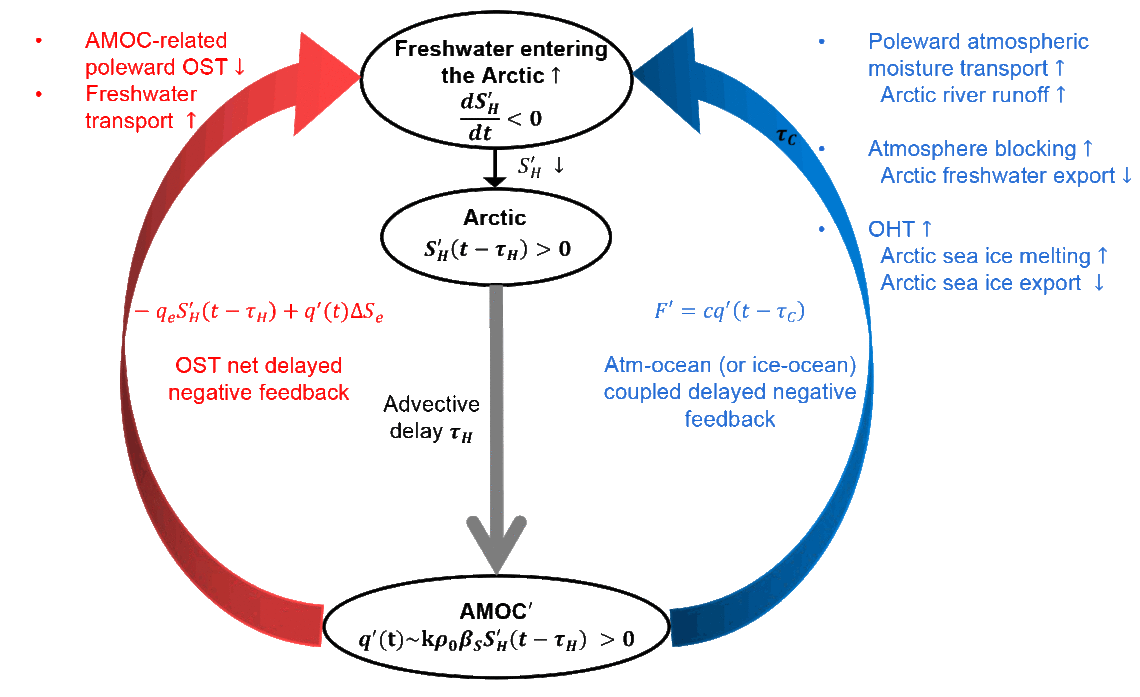August 29th, 2022
Key Findings
- A simple conceptual model was constructed to understand the two-way interaction of the Arctic with multidecadal AMOC variability through a delayed oscillator mechanism. Stommel’s Two-Box Model was revised to include the advective time delay for the Arctic density/salinity anomalies to reach the subpolar North Atlantic and the AMOC-induced coupled freshwater feedback.
- Multidecadal Atlantic Meridional Overturning Circulation (AMOC) variability exists in the revised Stommel’s Two-Box Model, with advective time delay and coupled freshwater feedback included.
- Regimes/periods of the AMOC delayed oscillator depend on the advective time lag of Arctic salinity signal and freshwater feedback strength.
- The model suggests an important role of the Arctic salinity and delayed negative freshwater feedback in the multidecadal AMOC variability.
Xinyue Wei, Rong Zhang. GRL. DOI: 10.1029/2022GL099800
Multidecadal variability of Atlantic Meridional Overturning Circulation (AMOC) has been reconstructed by various proxies, simulated in climate models, and linked to multidecadal Arctic salinity variability. However, the mechanisms of the multidecadal AMOC variability and its two-way interaction with the Arctic salinity anomaly, as well as the factors affecting the periods and amplitudes of the multidecadal AMOC variability are not well understood from the theoretical perspective using simple conceptual models.
Stommel’s Two-Box Model provides a pioneering and powerful theoretical framework to study the mechanisms of steady AMOC states and abrupt AMOC changes. However, Stommel’s Two-Box Model itself does not include a self-sustained multidecadal AMOC oscillation solution.
In this study, the authors revise Stommel’s Two-Box model by considering the delayed oceanic advective time lag for the Arctic density/salinity anomalies to reach the subpolar North Atlantic and the dependence of the freshwater flux entering the Arctic on the AMOC strength. The revised Stommel’s Two-Box Model is able to obtain the AMOC delayed oscillator at multidecadal timescales and suggests the important role of the Arctic salinity anomalies and associated delayed negative feedback in the multidecadal AMOC variability. The regimes and multidecadal periods of the AMOC delayed oscillator depend crucially on the advective time scale of the Arctic signal reaching the subpolar North Atlantic. The AMOC-related coupled freshwater feedback provides additional delayed negative feedback and reduces the threshold of the advective time delay needed for the multidecadal AMOC oscillations.
This research provides a fundamental understanding of the mechanism of the multidecadal AMOC variability. Using a conceptual model that is as simple as possible, this research provides a novel theoretical framework to understand the mechanisms of reconstructed and simulated multidecadal AMOC variability, its two-way interaction with the Arctic salinity variability, and the different variability periods simulated in climate models. This understanding will help to predict future variations in the AMOC and associated climatic, ecological, and economic impacts.



